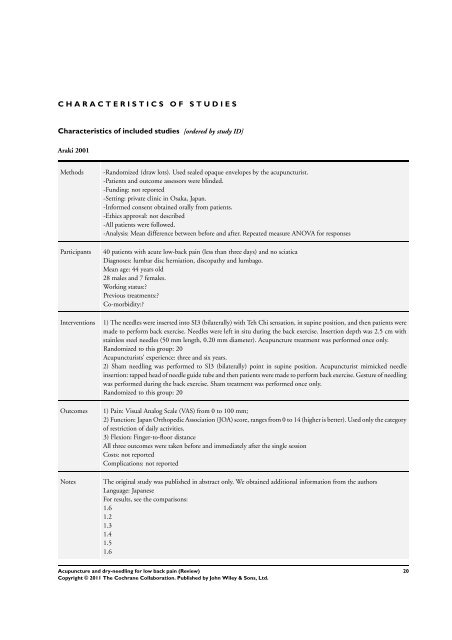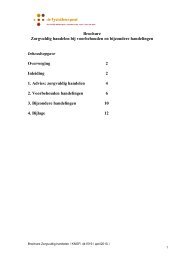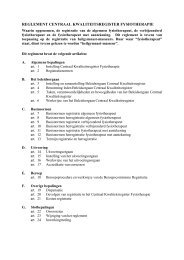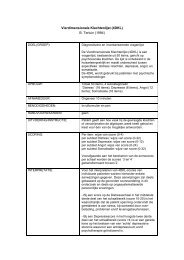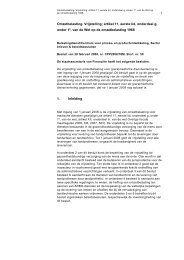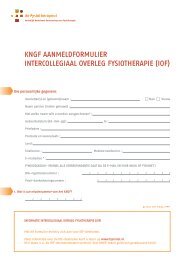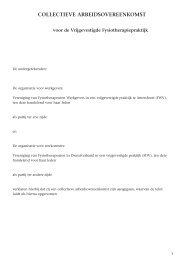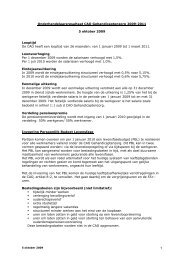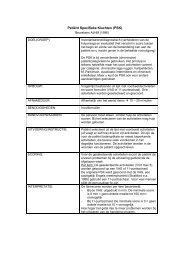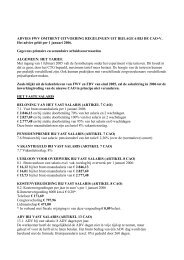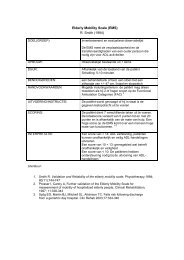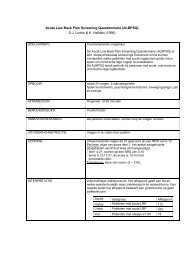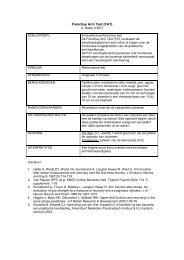Acupuncture and dry-needling for low back pain (Review)
Acupuncture and dry-needling for low back pain (Review)
Acupuncture and dry-needling for low back pain (Review)
Create successful ePaper yourself
Turn your PDF publications into a flip-book with our unique Google optimized e-Paper software.
C H A R A C T E R I S T I C S O F S T U D I E S<br />
Characteristics of included studies [ordered by study ID]<br />
Araki 2001<br />
Methods<br />
Participants<br />
Interventions<br />
Outcomes<br />
Notes<br />
-R<strong>and</strong>omized (draw lots). Used sealed opaque envelopes by the acupuncturist.<br />
-Patients <strong>and</strong> outcome assessors were blinded.<br />
-Funding: not reported<br />
-Setting: private clinic in Osaka, Japan.<br />
-In<strong>for</strong>med consent obtained orally from patients.<br />
-Ethics approval: not described<br />
-All patients were fol<strong>low</strong>ed.<br />
-Analysis: Mean difference between be<strong>for</strong>e <strong>and</strong> after. Repeated measure ANOVA <strong>for</strong> responses<br />
40 patients with acute <strong>low</strong>-<strong>back</strong> <strong>pain</strong> (less than three days) <strong>and</strong> no sciatica<br />
Diagnoses: lumbar disc herniation, discopathy <strong>and</strong> lumbago.<br />
Mean age: 44 years old<br />
28 males <strong>and</strong> 7 females.<br />
Working status:?<br />
Previous treatments:?<br />
Co-morbidity:?<br />
1) The needles were inserted into SI3 (bilaterally) with Teh Chi sensation, in supine position, <strong>and</strong> then patients were<br />
made to per<strong>for</strong>m <strong>back</strong> exercise. Needles were left in situ during the <strong>back</strong> exercise. Insertion depth was 2.5 cm with<br />
stainless steel needles (50 mm length, 0.20 mm diameter). <strong>Acupuncture</strong> treatment was per<strong>for</strong>med once only.<br />
R<strong>and</strong>omized to this group: 20<br />
Acupuncturists’ experience: three <strong>and</strong> six years.<br />
2) Sham <strong>needling</strong> was per<strong>for</strong>med to SI3 (bilaterally) point in supine position. Acupuncturist mimicked needle<br />
insertion: tapped head of needle guide tube <strong>and</strong> then patients were made to per<strong>for</strong>m <strong>back</strong> exercise. Gesture of <strong>needling</strong><br />
was per<strong>for</strong>med during the <strong>back</strong> exercise. Sham treatment was per<strong>for</strong>med once only.<br />
R<strong>and</strong>omized to this group: 20<br />
1) Pain: Visual Analog Scale (VAS) from 0 to 100 mm;<br />
2) Function: Japan Orthopedic Association (JOA) score, ranges from 0 to 14 (higher is better). Used only the category<br />
of restriction of daily activities.<br />
3) Flexion: Finger-to-floor distance<br />
All three outcomes were taken be<strong>for</strong>e <strong>and</strong> immediately after the single session<br />
Costs: not reported<br />
Complications: not reported<br />
The original study was published in abstract only. We obtained additional in<strong>for</strong>mation from the authors<br />
Language: Japanese<br />
For results, see the comparisons:<br />
1.6<br />
1.2<br />
1.3<br />
1.4<br />
1.5<br />
1.6<br />
<strong>Acupuncture</strong> <strong>and</strong> <strong>dry</strong>-<strong>needling</strong> <strong>for</strong> <strong>low</strong> <strong>back</strong> <strong>pain</strong> (<strong>Review</strong>)<br />
Copyright © 2011 The Cochrane Collaboration. Published by John Wiley & Sons, Ltd.<br />
20


